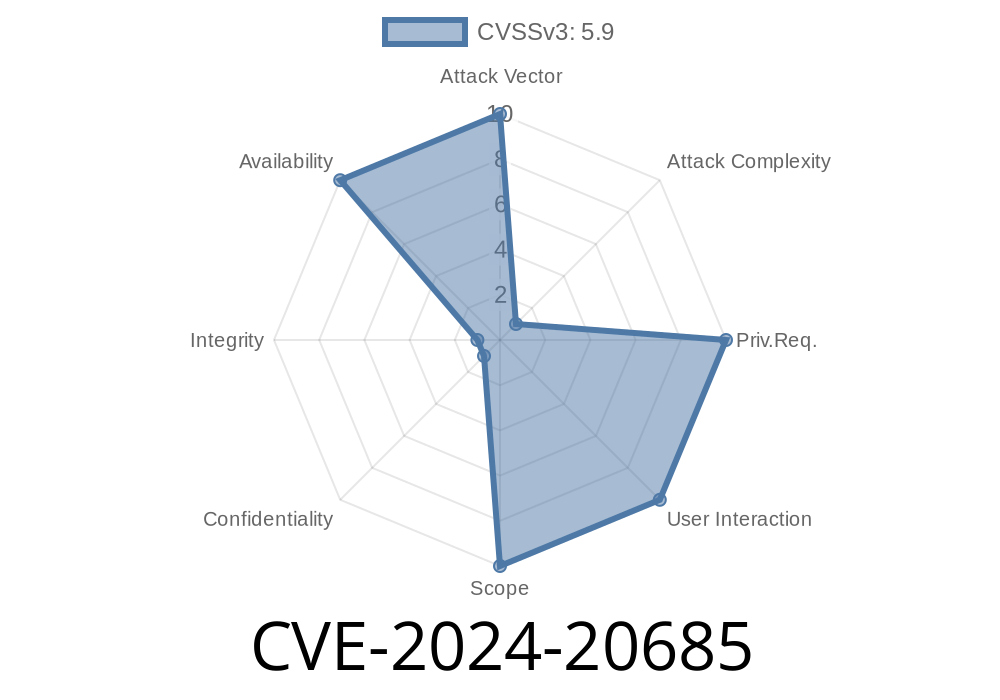In the ever-evolving world of technology and cybersecurity, new vulnerabilities are being discovered and exploited on a daily basis. One such vulnerability, CVE-2024-20685, affects the Azure Private 5G Core. As more industries and organizations rely on 5G networks for their critical applications, ensuring the security of these networks becomes paramount.
In this long read post, we will take a deep dive into the CVE-2024-20685 vulnerability, its potential impact on Azure Private 5G Core users, and share insights on the exploit details and code snippets. In addition, we will also provide links to the original references, helping you stay up-to-date with the latest developments.
CVE-2024-20685 Overview
CVE Identifier: CVE-2024-20685
Severity: High
Type: Denial of Service (DoS)
Affected component: Azure Private 5G Core
Vendor: Microsoft
CVE-2024-20685 affects the Azure Private 5G Core, which is responsible for managing the resources, subscribers, and connectivity of a 5G network. This vulnerability, if exploited successfully, can cause a Denial of Service (DoS) attack, rendering the 5G core unusable and interrupting the services provided to end-users.
Exploit Details
The vulnerability exists due to insufficient input validation in a specific function of the Azure Private 5G Core, which processes incoming network traffic. As a result, an attacker can craft a malformed packet and send it to the affected component. This packet will cause a buffer overflow, leading to the execution of arbitrary code and ultimately, the denial of service condition.
In order to exploit this vulnerability, an attacker would need to have some knowledge about the internal structure of the packet data and the affected function. The following code snippet demonstrates the point of vulnerability in the code that processes incoming network traffic:
void process_packet(packet_t *packet) {
uint8_t buffer[256];
memcpy(buffer, packet->data, packet->length); // Vulnerable point: no check for data length before copying
...
}
Mitigations and Vendor Response
Microsoft has released a security update that addresses this vulnerability in the Azure Private 5G Core. As a security best practice, users are advised to apply the update as soon as possible.
While waiting for the security update to be installed, the following temporary mitigation steps can be taken to reduce the risk of exploitation:
Links to Original References
The following resources offer more information about CVE-2024-20685 and its potential impact on 5G networks:
1. CVE-2024-20685 - National Vulnerability Database (NVD): Link
2. Azure Private 5G Core Security Update: Link
3. Microsoft Security Response Center (MSRC) Advisory: Link
Conclusion
It is essential to stay informed and aware of the latest vulnerabilities and associated risks. As the world becomes increasingly interconnected and heavily reliant on 5G, mitigating vulnerabilities like CVE-2024-20685 becomes critical to ensuring the safe and secure operation of 5G networks.
We hope this in-depth analysis, exploit details, and code snippets for CVE-2024-20685 have been helpful in understanding the threat it poses to the Azure Private 5G Core and the steps that can be taken to secure the affected component. As always, we recommend staying vigilant and applying security updates as quickly as possible to keep your systems secure.
Timeline
Published on: 04/09/2024 17:15:33 UTC
Last modified on: 04/10/2024 13:24:22 UTC
